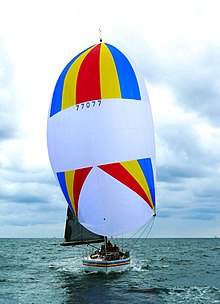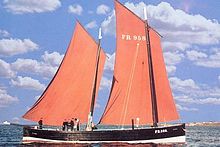
Back Устройство на ветроходното ветрило Bulgarian Allunament Catalan Устройство паруса Russian Parts of a sail SIMPLE Будова вітрила Ukrainian
Sail components include the features that define a sail's shape and function, plus its constituent parts from which it is manufactured. A sail may be classified in a variety of ways, including by its orientation to the vessel (e.g. fore-and-aft) and its shape, (e.g. (a)symmetrical, triangular, quadrilateral, etc.). Sails are typically constructed out of flexible material that is shaped by various means, while in use, to offer an appropriate airfoil, according to the strength and apparent direction of the wind. A variety of features and fittings allow the sail to be attached to lines and spars.
Whereas conventional sails form an airfoil with one layer of fabric, wingsails comprise a structure that has material on both sides to form an airfoil—much like a wing placed vertically on the vessel—and are beyond the scope of this article.




